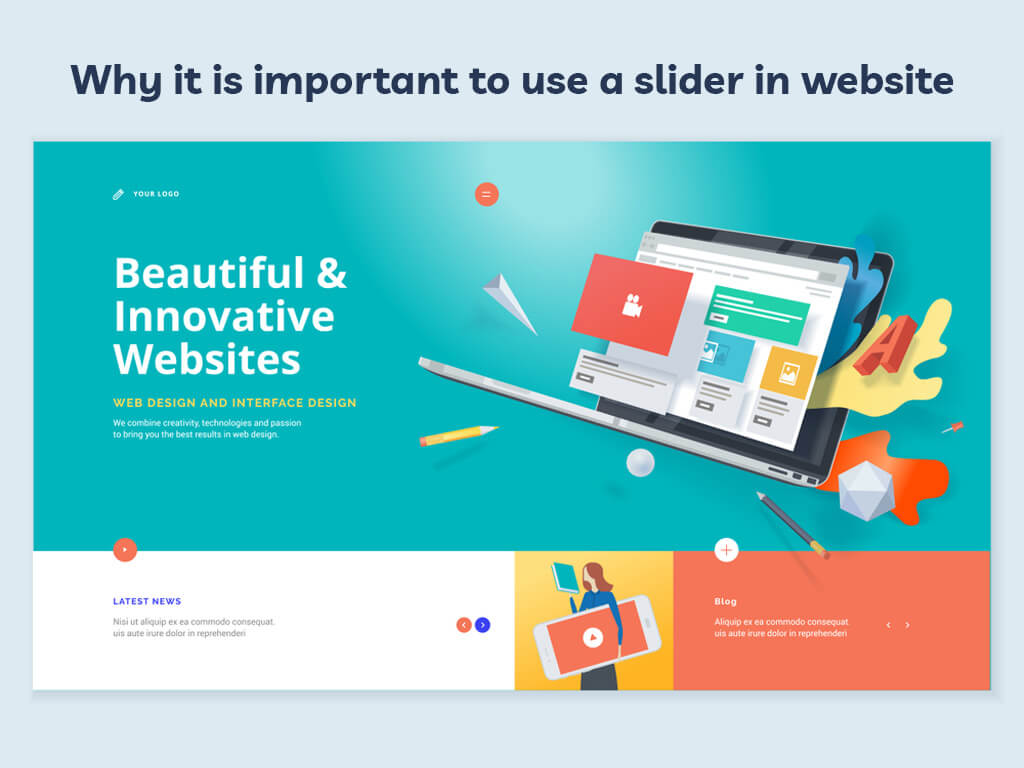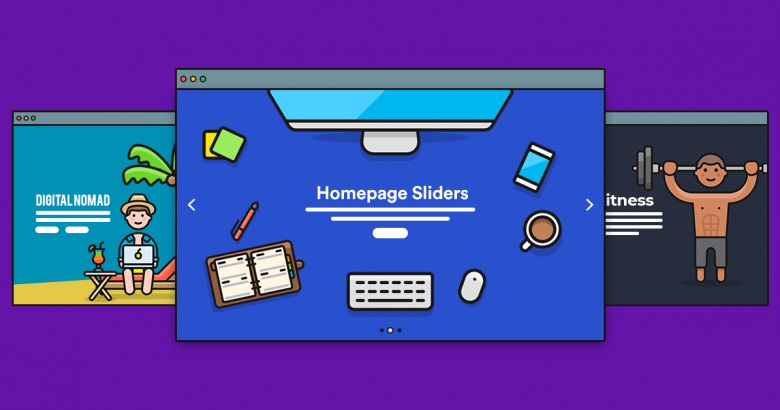What Is A slider in website?
A slider is a collection of images that appear in a certain order. A “Slideshow” or a “Carousel” is another name for it. The slider is usually found on a website’s homepage. Slider is first impression of any website so it creates good impact on landing users for any best websites. There are sliders on which the images are rotated automatically by a timer. Best web developers always prefer to choose right slider in website.
You’ve probably seen sliders on some of the websites you’ve visited. A slider in website for a hotel, for example, could have a slider in website with images from various locations.
You could begin by looking at an image of the hotel’s lobby or reception area. The image will change after a few seconds, and you may find yourself admiring the hotel’s main dining room or one of its luxury suites.
Manually controllable slideshows are also available. A manually controlled slideshow has the advantage of allowing you to take your time viewing the image. You can skip over the images that don’t interest you and focus on the ones that are more important.

What Are The Criticisms Vs The Slider Image?
Professional web designers have differing opinions on whether or not your slider in website should have a slider image.
Here are four reasons why some web designers believe a slider in website image should not be used on your slider in website:
Sliders Can Make Your Marketing Message Confusing –
The use of a slider can muddle your marketing message because most people perceive them as advertising.
Sliders don’t improve the user experience. –
Nielsen discovered that a slider in website can cause a condition known as “banner blindness” in the same study. This indicates that users are unable to see or comprehend the information presented in the slides. As a result, the additional confusion may cause the visitor to abandon your slider in website.
Sliders Can Slow Down Your Page’s Loading –
Because sliders use high-resolution images, some web designers warn that this may have a negative impact on your site’s loading speed.
Mobile Responsiveness Will Be Affected by Sliders –
Another criticism is that some slider configurations don’t work well on mobile devices, compromising the responsiveness of your site.
The web designers who are opposed to the slider believe it will have a negative impact on SEO. The use of a slider will have an impact on user experience, page loading speed, and mobile responsiveness, and as a result, you may be pushed further down in Google’s search rankings.
What Are The Advantages Of Using A Slider Image On Your Website?
While we respect the views of our professional web design, we at Mountaintop have a different point of view. On the homepage, we believe you should have a slider image.
Here are four compelling reasons to include a slider image on your slider in website:
Your marketing message can be organised and fine-tuned using a slider. –
“A picture is worth a thousand words,” as the saying goes. Images are more effective at conveying messages than text. According to studies, only 10% of people who read or hear information three days later remember it. More than 65 percent of people who see images that are relevant to the information, on the other hand, will remember it even three days later.
A slider in website Can Improve Your Homepage’s Overall Visual Appeal –
According to a study conducted by Stanford University with 2,500 participants, 46.1 percent of those polled believe that slider in website design is a significant indicator of credibility. A slider made up of beautiful, high-resolution images will undoubtedly catch the attention of the visitor, entice him or her to stay longer and possibly explore the rest of the website.
A Slider Can Make Your Site More Functional –
What are your goals for the slider on your slider in website? Do you want your company’s information to be displayed on the slider? Is the slider meant to be a moving portfolio of your services and products? Will the slider be used to boost your credibility by rotating different client testimonials? Whatever you want the slider to do, it will succeed because everything will be in one location. The visitor will not travel elsewhere.
The User Experience Will Be Improved By Using A Slider –
A visitor who clicks on your slider will be kept in one place, as we mentioned in the previous point. On the slider, he can find everything he needs to know. It will make your site visitor’s search process much easier. The slider will keep them on your site longer. Its contents will assist them in determining whether or not they should continue to explore your slider in website. You can also have a manual slider on your homepage instead of an automatic slider, as we mentioned earlier in this article. Because the user can take his or her time on the image with the highest perceived value, UX will improve.
How to Create a Slider Image That Produces Results:
- A slider can assist you in achieving your marketing goals. At Mountaintop, we’ve done exactly that for our clients.
- Images have been shown to be a powerful tool for communicating your digital marketing message. The attention span of visual or image-based content is shorter than that of text-based content.
- Now that we’ve captured the visitor’s attention, let’s keep him or her engaged by rotating the image. Let us show him/her an image of the bathroom from the bedroom, then move on to the balcony with a view of the ocean.
- Words alone will not do justice to the resort’s beauty. Pictures, on the other hand, will be closer. Maybe close enough for the visitor to take the next step and ask a question.
- We conducted our own research into the benefits and drawbacks of having a slider image on a website’s homepage. The arguments made by those who oppose the use of a slider in website are valid and were taken into consideration.
1. Define the Slider Image’s Purpose –

The purpose of the message is always the first step in the messaging process for digital marketers. What do you want your audience to take away from your message? At any given time, only one message can be sent. If you concentrate on multiple messages, you will only confuse your audience.
Start by defining the purpose of your slider in website image to avoid confusion and “banner blindness.”
If you sell products online, you can use the slider in website image to display your best-selling or most popular items. Use the slider image to highlight client testimonials if you’re in the consulting business. A slideshow can be used by a restaurant to inform customers about daily specials or promotions.
2. Use Relevant Images –
Find images that are relevant to your marketing message once you’ve determined the purpose of the slide image.
Don’t try to be “fancy” or “artsy” by using images that are primarily symbolic of your message but are very beautiful and aesthetic. Visitors to a slider in website don’t want to be put through tests or guesswork.
Remember that a person’s attention span is less than that of a goldfish! When it comes to content, get right to the point. You can also use a combination of image and text to convey your message more clearly and quickly.
3. Use High-Resolution Images But… –
For aesthetic reasons, web designers will advise using high-resolution images. However, because the file is larger and more difficult to download, it will slow down page loading speed.
For the slideshow, we’ll continue to use high-resolution images. Use smaller images, however, to ensure that the page loads quickly.
4. Switch from Slide to Motion-Fade –
One of the criticisms levelled at the use of slider in website images by web designers is that it detracts from the user experience by diverting the viewer’s attention.
The culprit, according to our research, is the slide-to-slide transition. The transition may appear too “sudden” or “sharp” to some viewers.
Instead of using a slide-to-slide transition, we decided to use a motion fade. This will result in a more fluid viewing experience. The gradual fadeout will alert the audience that the slide is in the midst of a transition.
He or she will be much better able to adjust the thought process and prepare for the next slide.
5. Consider a Manual Slide Image –
Throughout this article, we’ve discussed the advantages of a manual slide. It’s worth repeating that using a manual slider image improves user experience by giving the user more control.
A manual slider will give the viewer more time to go through your content if your goal is to promote your products and services.
6. Beta Test Your Images –
The first slide, predictably, receives the greatest number of clicks.
As a result, it’s critical to conduct a beta test to determine which of your images receives the most positive feedback or achieves the desired result. Choosing the right image for your slider image will help set the tone for the rest of it.



